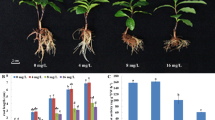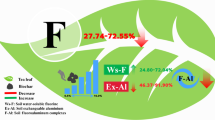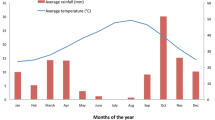Abstract
Background and aims
Tea is a strong accumulator of both aluminium (Al) and fluoride (F). We tested the hypothesis that Al helps detoxify F in tea plants by forming Al-F complexes.
Methods
Tea plants were grown hydroponically with a range of Al and F concentrations and in a soil pot experiment with amendments of NaF and acids. Growth and the uptake of F and Al were determined. Chemical species of F in the nutrient solutions and the cell saps of roots and leaves were determined by 19F NMR.
Results
In hydroponic experiments, F inhibited the growth of new roots and shoot tips in the absence of Al in the nutrient solutions, whereas Al stimulated root growth and alleviated the toxicity of F. Aluminium generally increased F concentration in roots but decreased F concentration in leaves. Geochem-PC calculations and 19F NMR showed the presence of AlF2+, AlF2 + and AlF3 0 in the nutrient solutions when Al and F were present. Aluminium markedly decreased the NMR peak of free F in the cell saps from roots and leaves. An Al-F complex likely to be AlF2+ was detected in the leaf cell sap from the plants treated with both F and Al. In the soil pot experiment, F caused leaf necrosis when the leaf Al to F molar ratio was smaller than 1.
Conclusions
Tea plants are sensitive to F toxicity in the absence of Al. Aluminium alleviates F toxicity in tea by forming Al-F complexes.







Similar content being viewed by others
References
Arnesen AKM (1997) Availability of fluoride to plants grown in contaminated soils. Plant Soil 191:13–25
Barbier O, Arreola-Mendoza L, Del Razo LM (2010) Molecular mechanisms of fluoride toxicity. Chem Biol Interact 188:319–333
Bar-Yosef B, Rosenberg R (1988) Response of corn and tomato plants to fluorine concentration in solution culture. Agron J 80:173–177
Clausen LPW, Karlson UG, Trapp S (2015) Phytotoxicity of sodium fluoride and uptake of fluoride in willow trees. Int J Phytorem 17:369–376
Davison AW (1983) Uptake, translocation and accumulation of soil and airborne fluorides in vegetation. In: Shupe JL, Peterson LB, Leone NC (eds) Fluorides: effects on vegetation, animals and humans. Paragon Press, Salt Lake City, pp 61–68
Fung KF, Zhang ZQ, Wong JWC, Wong MH (1999) Fluoride contents in tea and soil from tea plantations and the release of fluoride into tea liquor during infusion. Environ Pollut 104:197–205
Gao HJ, Zhao Q, Zhang XC, Wan XC, Mao JD (2014) Localization of fluoride and aluminum in subcellular fractions of tea leaves and roots. J Agric Food Chem 62:2313–2319
Ghanati F, Morita A, Yokota H (2005) Effects of aluminum on the growth of tea plant and activation of antioxidant system. Plant Soil 276:133–141
Gutknecht J, Walter A (1981) Hydrofluoric and nitric acid transport through lipid bilayer membranes. Biochim Biophys Acta 644:153–156
Hajiboland R, Barcelo J, Poschenrieder C, Tolra R (2013a) Amelioration of iron toxicity: a mechanism for aluminum-induced growth stimulation in tea plants. J Inorg Biochem 128:183–187
Hajiboland R, Rad SB, Barcelo J, Poschenrieder C (2013b) Mechanisms of aluminum-induced growth stimulation in tea (Camellia sinensis). J Plant Nutr Soil Sci 176:616–625
Jacobson JS, Weinstein LH, McCune DC, Hitchcock AE (1966) The accumulation of fluorine by plants. J Air Pollut Control Assoc 16:412–417
Jha SK, Nayak AK, Sharma YK (2009) Fluoride toxicity effects in onion (Allium cepa L.) grown in contaminated soils. Chemosphere 76:353–356
Kinraide TB (1997) Reconsidering the rhizotoxicity of hydroxyl, sulphate, and fluoride complexes of aluminium. J Exp Bot 48:1115–1124
Konishi S, Miyamoto S, Taki T (1985) Stimulatory effects of aluminum on tea plants grown under low and high phosphorus supply. Soil Sci Plant Nutr 31:361–368
Li S, Smith KD, Davis JH, Gordon PB, Breaker RR, Strobel SA (2013) Eukaryotic resistance to fluoride toxicity mediated by a widespread family of fluoride export proteins. Proc Natl Acad Sci U S A 110:19018–19023
Loganathan P, Hedley MJ, Wallace GC, Roberts AHC (2001) Fluoride accumulation in pasture forages and soils following long-term applications of phosphorus fertilisers. Environ Pollut 115:275–282
Maclean DC, Hansen KS, Schneider RE (1992) Amelioration of aluminum toxicity in wheat by fluoride. New Phytol 121:81–88
Morita A, Yanagisawa O, Takatsu S, Maeda S, Hiradate S (2008) Mechanism for the detoxification of aluminum in roots of tea plant (Camellia sinensis (L.) Kuntze). Phytochemistry 69:147–153
Nagata T, Hayatsu M, Kosuge N (1992) Identification of aluminum forms in tea leaves by Al-27 NMR. Phytochemistry 31:1215–1218
Nagata T, Hayatsu M, Kosuge N (1993) Aluminum kinetics in the tea plant using Al-27 and F-19 NMR. Phytochemistry 32:771–775
Parker DR, Norvell WA, Chaney RL (1995) GEOCHEM-PC - a chemical speciation program for IBM and compatible personal computers. In: Loeppert RH, Schwab AP, Goldberg S (eds) Chemical equilibrium and reaction models. Soil Science Society of America, American Society of Agronomy, Madison, pp 253–269
Ruan JY, Wong MH (2001) Accumulation of fluoride and aluminium related to different varieties of tea plant. Environ Geochem Health 23:53–63
Ruan JY, Ma LF, Shi YZ, Han WY (2003) Uptake of fluoride by tea plant (Camellia sinensis L) and the impact of aluminium. J Sci Food Agric 83:1342–1348
Ruan JY, Ma LF, Shi YZ, Han WY (2004) The impact of pH and calcium on the uptake of fluoride by tea plants (Camellia sinensis L.). Ann Bot 93:97–105
Smith KD, Gordon PB, Rivetta A, Allen KE, Berbasova T, Slayman C, Strobel SA (2015) Yeast Fex1p is a constitutively expressed fluoride channel with functional asymmetry of its two homologous domains. J Biol Chem 290:19874–19887
Sparks DL (1996) Methods of soil analysis. Part 3. Chemical Methods American Society of Agronomy, Soil Science Society of America Madison, Wisconsin, USA
Stevens DP, McLaughlin MJ, Alston AM (1997) Phytotoxicity of aluminium-fluoride complexes and their uptake from solution culture by Avena sativa and Lycopersicon esculentum. Plant Soil 192:81–93
Stevens DP, McLaughlin MJ, Alston AM (1998) Phytotoxicity of the fluoride ion and its uptake from solution culture by Avena sativa and Lycopersicon esculentum. Plant Soil 200:119–129
Stevens DP, McLaughlin MJ, Randall PJ, Keerthisinghe G (2000) Effect of fluoride supply on fluoride concentrations in five pasture species: levels required to reach phytotoxic or potentially zootoxic concentrations in plant tissue. Plant Soil 227:223–233
Takmaz-Nisancioglu S, Davison AW (1988) Effects of aluminum on fluoride uptake by plants. New Phytol 109:149–155
Weinstein LH, Davison AW (2004) Fluorides in the environment. CABI Publishing, Wallingford
Wong MH, Fung KF, Carr HP (2003) Aluminium and fluoride contents of tea, with emphasis on brick tea and their health implications. Toxicol Lett 137:111–120
Yumada H, Hattori T (1977) Investigation of the relationship between aluminium and fluorine in plants (Part I). Relationship between aluminium and fluorine in tea leaves. Jpn J Soil Sci Plant Nutr 48:253–261
Zhang L, Li Q, Ma L, Ruan J (2013) Characterization of fluoride uptake by roots of tea plants (Camellia sinensis (L.) O. Kuntze). Plant Soil 366:659–669
Acknowledgments
The study was funded by Unilever Research and Development, the Innovative Research Team Development Plan of the Ministry of Education of China (grant IRT1256), the Priority Academic Program Development of Jiangsu Higher Education Institutions (PAPD) and the and the 111 project (B12009). We thank Dr Jianyun Ruan for providing seeds and seedlings of tea used in the present study.
Author information
Authors and Affiliations
Corresponding author
Additional information
Responsible Editor: Jian Feng Ma .
Electronic supplementary material
Below is the link to the electronic supplementary material.
ESM 1
(PDF 107 kb)
Rights and permissions
About this article
Cite this article
Yang, Y., Liu, Y., Huang, CF. et al. Aluminium alleviates fluoride toxicity in tea (Camellia sinensis). Plant Soil 402, 179–190 (2016). https://doi.org/10.1007/s11104-015-2787-8
Received:
Accepted:
Published:
Issue Date:
DOI: https://doi.org/10.1007/s11104-015-2787-8




